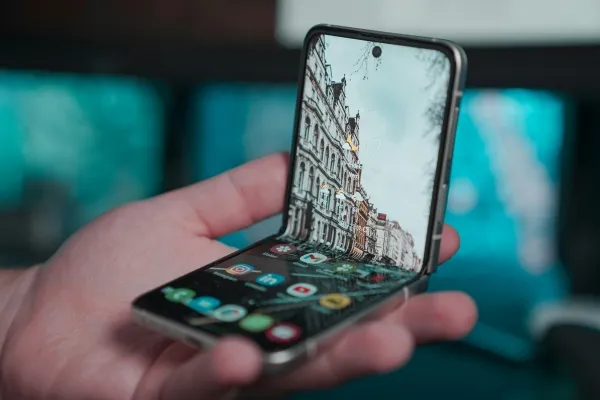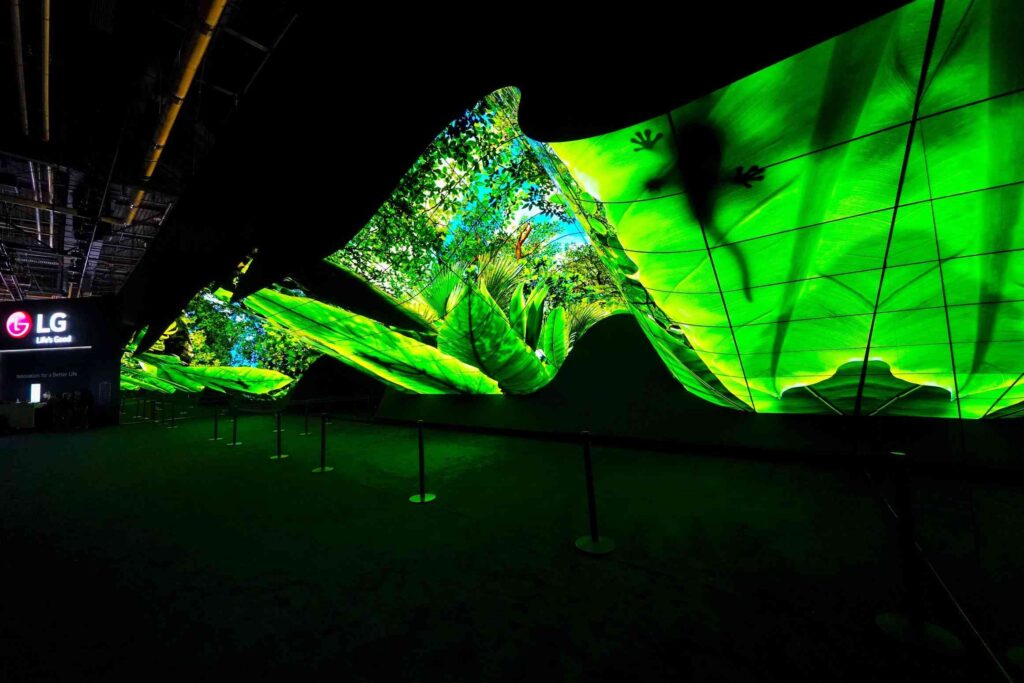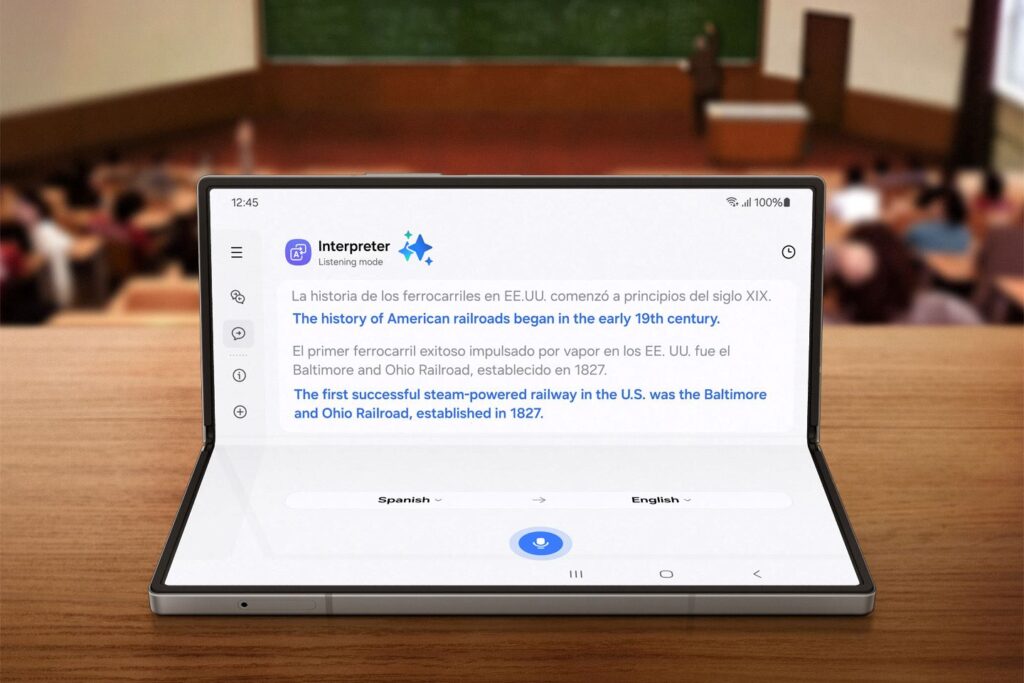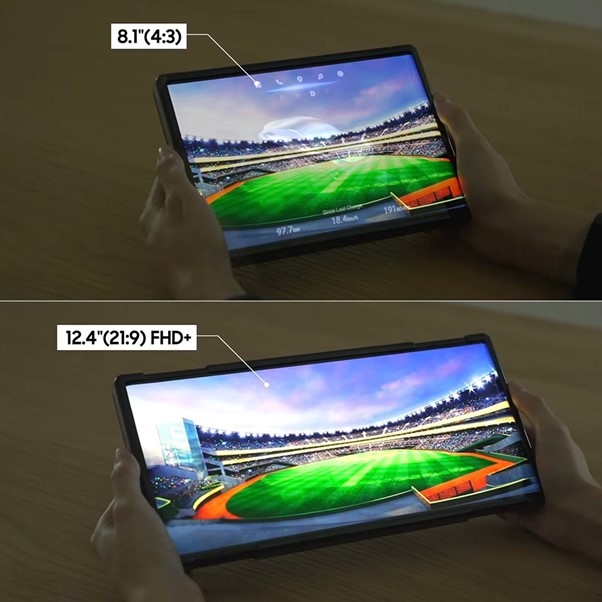Flexible Displays – From concept to commercialisation

At the beginning of the year, we caught a glimpse of some of the most exciting new technologies coming onto the scene at the Consumer Electronics Show (CES). CES is the world leading consumer technology event held annually in January in Las Vegas by the Consumer Technology Association. It provides a place for innovators in electronics to present their upcoming products and is famous for the concept devices on display. Among them, Samsung’s impressive lineup of flexible displays – featuring foldable, rollable and even stretchable – left this writer truly star-struck. We decided to take a look at the history of flexible displays, their current status and what to expect in the future.
A brief history of flexible displays
Flexible displays have been touted as one of the most exciting functionalities of organic light emitting diodes (OLEDs). However, actually turning this idea into a reality has taken its time. OLEDs are a type of emissive material composed of organic compounds which emit light following application of an electrical current. They form the pixels in many different display devices, and it is likely they will be present in your smartphone or smart watch where they dominate the market share. They are also used in some TVs and other flat panel displays, competing alongside quantum dot and conventional liquid crystal displays (LCD). Lower energy consumption and amazing picture quality are usually their key selling points, but it is their use in flexible displays which we will discuss in this article.
My background is in OLEDs, and during presentations from professors and industry leaders, we were frequently shown images of concept products with two from LG standing out: one from 2014 which showed a bendable OLED TV and another from 2016, a rollable “newspaper like” display. They were shown to highlight the unique flexible potential of OLEDs, distinguishing them over conventional displays such as LCD, but we never saw these two make it to Market (not yet anyway). OLEDs have made flexible displays possible, as they can be fabricated onto flexible substrates like plastics. All of the commercial flexible displays discussed next use this technology, except the stretchable concept devices where micro-LEDs are used instead.

First Generation Flexible Displays – The age of the curved edge
Both Samsung and LG have actually been producing flexible displays in commercial products for around 10 years, but in these products, users could not manipulate the displays themselves. The flexible displays used OLEDs and were applied to a fixed surface producing curved displays. Both companies produced curved smart phones back in 2013, the LG Flex and the Samsung Galaxy Round, with neither really taking off. The LG Flex offered some flexibility when the phone was put under pressure, but this was a far cry from the concept newspaper device. The Samsung Galaxy Edge series was commercially more successful, launching initially in 2014, with curved edges and although the actual usefulness of the curved screen is debatable, it was an interesting shift from the conventional flat displays. It is worth noting that the curved displays revolution has largely vanished from phones now, but we still see them in some larger screens.
Second generation Flexible Displays – Some ‘flipping’ amazing products
In 2018, we saw the next step in flexible displays when Royole released the first foldable display which users could flex themselves, Royole FlexPai. The phone had a single display, which could be folded over, providing a larger screen while the overall device was compact. In this first device, the screen was on the outside, with a hinge system in the middle controlling the extent of flexibility. They pipped Samsung to this title by a few months, with the Galaxy Fold entering the scene shortly after, with a screen on the inside of the fold. Both products were huge steps in flexible displays, although initial reviews highlighted problems. On a personal level, seeing a foldable display in a store which consumers could get their hands on (if their pockets were deep enough, it retailed near $2,000!) was amazing. It didn’t quite provide the size of the bendable TV or the flexibility of the rollable display but it was a start. These folding phones were teased for years before, with a commercial showing prototype folding devices at CES 2013, but finally seeing concept brought to reality was a great step!

We are now entering the 6th iteration of the Galaxy Fold, while a smaller version has been successful, the Galaxy Flip, which also offers a hinge-like design with a bendable display in the middle. These flip phones might remind readers of the hottest phones from the 2000s, which included the Motorola Razr. Indeed, Motorola have produced an OLED version, also called the Motorola Razr, released in 2020, 16 years after the original series. It is not only Samsung and Motorola in the flexible phone market, with Huawei, Google, Nubia and OnePlus all pushing their own types, while Apple are rumored to be entering the market in the next couple of years.
For foldable displays, there are some interesting recent developments including using more than 2 panels, with Huawei launching a 3-panel device last year, the Huawei Mate XT Ultimate Design. Samsung and others have presented 360° flipping concept devices where users can flip the screen in both directions, calling their device the “Flex In&Out”, no expected date has been shared, but it’s fair to assume that this would be the next iteration. Recently, Samsung displayed two new foldable innovations, the “Flexible Briefcase” – a large area folding device which was portable and the “Flex Gaming” system – a foldable device for handheld gaming applications. Foldable displays are here to stay, with an expected 22 million units to be shipped this year. Of course, work to implement into larger displays and reducing device costs are essential.
Third Generation Flexible Displays? – Roll-on the next generation
Since the folding and flipping revolution of small area displays, we have not seen much commercial movement in new types. Several concept products have emerged, using rollable technologies, with Samsung and Motorola presenting them in 2023. Here, the OLED screen can be extended, increasing the display size when a button is pressed, with the screen unrolling from inside the device. At the CES 2025 event, Samsung presented devices – Samsung Slidable Flex Duet – where they were pulled by hand to stretch in tablet and phone devices.

Samsung have also announced that their rollable laptop which was presented at CES, produced in conjunction with Lenovo, is more than a concept, with an expected launch in June this year. Strictly speaking, commercial rollable products are not new in large area displays with rollable OLED TVs originally launched by LG. Here the screen was rolled up and hidden inside a box, unravelling to reveal the display, not the screen extension mentioned above. However, these were recently scrapped due to low sales, likely due to their high price tag of $87,000. An alternative concept piece from Samsung combined both flipping and sliding, in a device they termed “Flex Hybrid”.
The future of Flexible Displays – Diving into the IP
So what’s next? We have seen some concept rollable devices and of course the amazing stretching screen, but can we predict where the market is going?
We decided to take a brief dive into the IP surrounding flexible displays and see what is going on, with IP often a useful way to predict upcoming trends and products. Here, we look at patents as the form of IP to predict trends as these are freely available in the public domain. At SAL, we often use patent searching as a method to identify new technologies or performing competitor analysis, while we have also undertaken projects at the other end of the spectrum designed to stimulate IP generation.
We searched the CPC code associated with flexible devices (G06F1/1652) and captured all patents historically. As expected, Samsung dominate the flexible display patent landscape, accounting for over a third of the simple patent families issued historically. LG unsurprisingly are second on the list with BOE and China Star, two Chinese developers, occupying third and fourth positions, respectively. In line with the concept products and commercial deployment, we observe a spike in patent applications after 2018 with the yearly applications doubling from around 500 in 2018 to over 1,000 by 2020.
We took a deeper dive into patent development over the past two years (until application date 24-02-2023). Over this time frame, we do see a large proportion geared towards the rollable displays, often discussed as “sliding” devices. These are mainly the screen extender-like designs, similar to the concept phone from Samsung and their laptop. Design specifications of their CES tablet device are reported in patents, while we can see their concept phone in several patents. The rollable patents are tackling some problems such as oversliding, scratching of the surface and other ways to improve lifetime and durability. The frequency and breadth of patents emerging using this technology strongly suggest commercialisation is on the horizon, with companies aiming to shore up their positions.
Output in the foldable displays is also ongoing, contributing to the largest amount of recent patents according to our analysis. They include strategies to prevent or minimise surface defects and folding marks, allow folding-in forward and backward directions, and lots of work discussing improving the hinge component.
There is also some movement in the stretchable displays, mainly coming from Samsung. The patents are primarily covering strategies to improve durability of these stretchable systems, including changing materials and the layout of pixels, but these are minor compared to the rolling and folding technologies.
Beyond these three development themes, we identified several interesting patents potentially hinting at future products:
- US20240324128A1 from LG shows a display where users can alter the extent of the curvature themselves, offering enhanced customisation for users, likely used in larger displays.
- A patent from Apple shows devices where the displays are visible on all surfaces, wrapped around a core unit of different shapes – US20240302865A1.
- Samsung had a hidden screen tablet-like device, where the screen rolls up inside a small box – US20240373732A1.
- There are also several patents covering extendable screens in smart watches, including US20230384825A1 from Medibotics.
- US20230315156A1 from Samsung indicates a potentially new design, where the display of the phone can be extended in two positions to reveal additional interfaces and a larger display in a T-shaped design.
- Another patent from Samsung reveals an alternative laptop design, where the screen extends horizontally instead of the vertical extension in their collaboration with Lenovo, US20240061470A1, which might finally remove the need for a second screen!
Conclusion
We have observed through our brief study the development of flexible displays, with rollable clearly the next generation. A laptop screen extension from Samsung is expected to enter the scene this year, while their concept devices and the patent movement hint towards phones and tablets soon. Although, there are some stretchable patents recently entering the space, they are only minor compared to the other areas, and we expect this class to be limited to concept pieces for the foreseeable future. Despite our dive into the patent landscape, we couldn’t find anything which stood out as a completely new design with sliding, folding and stretching here to stay. Unfortunately, it seems that the newspaper-like device that inspired me at the start of my studies is unlikely to ever reach commercialisation, and maybe my lesson here is to take concept products with a pinch of salt, most of them won’t make it beyond the CES concourse!
Strategic Allies Ltd (SAL) have worked with multinational clients across various industries who are interested in identifying new and innovative technologies. If you’d like to find out more about how we can help you to explore and exploit new markets and/or offer opportunities to differentiate your offerings, please contact John Allies at john@strategicallies.co.uk